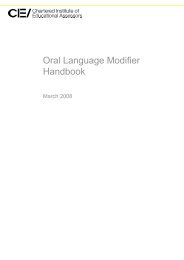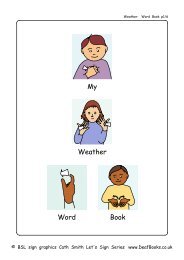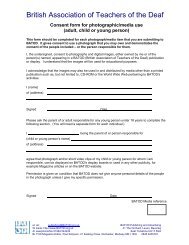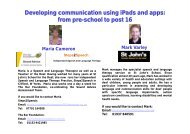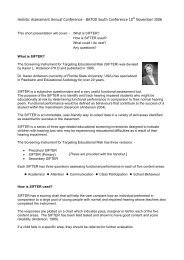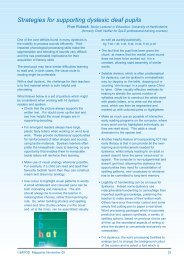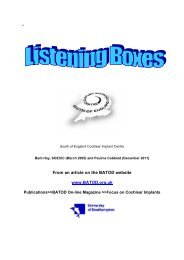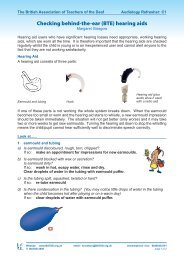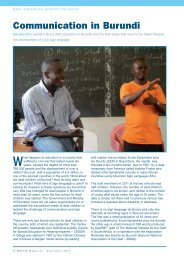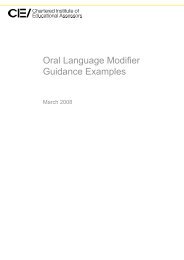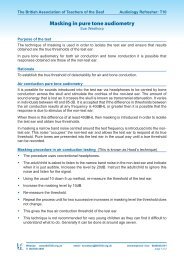Goal fulfilment in school for the deaf and hearing impaired - batod
Goal fulfilment in school for the deaf and hearing impaired - batod
Goal fulfilment in school for the deaf and hearing impaired - batod
- No tags were found...
You also want an ePaper? Increase the reach of your titles
YUMPU automatically turns print PDFs into web optimized ePapers that Google loves.
Table 1. Types of <strong>school</strong> exam<strong>in</strong>ed under <strong>the</strong> project.Special <strong>school</strong>Compulsory <strong>school</strong>Local <strong>school</strong>s <strong>and</strong> Independent <strong>school</strong>sa) Schools <strong>for</strong> <strong>the</strong> hear<strong>in</strong>g <strong>impaired</strong>b) Small classes <strong>for</strong> <strong>the</strong> hear<strong>in</strong>g <strong>impaired</strong>c) Individually placedCompulsory <strong>school</strong><strong>for</strong> pupils withlearn<strong>in</strong>g disabilitiesThe <strong>school</strong>s <strong>for</strong> <strong>the</strong> hear<strong>in</strong>g <strong>impaired</strong> sometimesonly admit pupils from <strong>the</strong>ir own municipality,but certa<strong>in</strong> <strong>school</strong>s also admit pupils from o<strong>the</strong>rmunicipalities. SISresources (Special <strong>in</strong>itiatives <strong>in</strong><strong>school</strong>) help to stimulate this activity.Sami <strong>school</strong>s are not <strong>in</strong>cluded <strong>in</strong> <strong>the</strong> comparisons<strong>in</strong>ce <strong>the</strong>re are very few hear<strong>in</strong>g <strong>impaired</strong> or<strong>deaf</strong> pupils who attend this type of <strong>school</strong>.(See abbreviation <strong>for</strong> more <strong>in</strong><strong>for</strong>mation aboutSami<strong>school</strong>).Special <strong>school</strong>sSpecial <strong>school</strong>s are a type of <strong>school</strong> <strong>for</strong> <strong>deaf</strong><strong>and</strong> hear<strong>in</strong>g <strong>impaired</strong> pupils who, due to <strong>the</strong>irhear<strong>in</strong>g losses, cannot attend compulsory<strong>school</strong>. Special <strong>school</strong>s have years 1‐10 <strong>and</strong> areregulated by <strong>the</strong> Education Act, <strong>the</strong> SpecialSchool Ord<strong>in</strong>ance, <strong>the</strong> Lpo 94 curriculum <strong>and</strong><strong>the</strong> national syllabuses. To as great an extentas possible, special <strong>school</strong>s should emulatecompulsory <strong>school</strong>s, while, with <strong>the</strong>ir bil<strong>in</strong>gualenvironment, <strong>the</strong>y should be adapted to<strong>the</strong> needs of <strong>the</strong>ir pupils (Skolverket 2004b;Hermanson & Drav<strong>in</strong>s 2007). The syllabuses <strong>for</strong><strong>the</strong> subjects Sign Language, Swedish, English,Modern Languages <strong>and</strong> Movement <strong>and</strong> dramaare adapted to this particular type of <strong>school</strong>. Thetimetable is also adapted.The number of <strong>deaf</strong> <strong>and</strong> hear<strong>in</strong>g <strong>impaired</strong> pupilsattend<strong>in</strong>g special <strong>school</strong>, compared to those whochoose o<strong>the</strong>r types of <strong>school</strong>s, varies when seenfrom a longer perspective. Dur<strong>in</strong>g <strong>the</strong> 1960s ,follow<strong>in</strong>g political decisions <strong>and</strong> technologicaldevelopments <strong>in</strong> <strong>the</strong> area of hear<strong>in</strong>g, manypupils left <strong>in</strong>stitutions/special <strong>school</strong>s <strong>and</strong> were<strong>in</strong>tegrated <strong>in</strong>to ord<strong>in</strong>ary <strong>school</strong>s; as a result <strong>the</strong>number of pupils went down from 507 to 339<strong>in</strong> 10 years (Lundahl & Od<strong>in</strong> 1974). From<strong>the</strong> early 1980s to <strong>the</strong> mid 1990s <strong>the</strong> numberof pupils <strong>in</strong>creased at special <strong>school</strong>s <strong>for</strong> <strong>the</strong><strong>deaf</strong> <strong>and</strong> hear<strong>in</strong>g <strong>impaired</strong> when sign languagewas recognized as a language of <strong>in</strong>struction <strong>in</strong>1981. Although after 2000 <strong>the</strong> number fellaga<strong>in</strong> (Skolverket 2004b). The number of pupilsattend<strong>in</strong>g special <strong>school</strong> depends on <strong>the</strong> natureof educational policy, development <strong>in</strong> hear<strong>in</strong>gtechnology, <strong>the</strong> birth rate <strong>and</strong> <strong>the</strong> attitudes ofparents <strong>and</strong> o<strong>the</strong>rs – habilitation <strong>and</strong> healthcaresectors – to this type of <strong>school</strong>.So to a greater extent than <strong>in</strong> o<strong>the</strong>r parts of <strong>the</strong>education system, <strong>the</strong> number of <strong>deaf</strong> childrenattend<strong>in</strong>g special <strong>school</strong>s is dependent on <strong>the</strong>govern<strong>in</strong>g documents of <strong>the</strong> <strong>school</strong>, as well as<strong>the</strong> views of pupils, parents, user organizations<strong>and</strong> hear<strong>in</strong>g habilitation professionals. This typeof <strong>school</strong> should, <strong>in</strong> o<strong>the</strong>r words, satisfy severaldifferent, <strong>and</strong> sometimes contradictory, needs.<strong>Goal</strong> <strong>fulfilment</strong> <strong>in</strong> <strong>school</strong> <strong>for</strong> <strong>the</strong> <strong>deaf</strong> <strong>and</strong> hear<strong>in</strong>g <strong>impaired</strong>17



